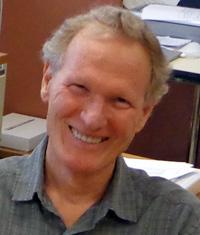
This year’s series of special sessions on salt tectonics (“Salt Involved Systems: Deposition to Diapirism to Dissolution”) is dedicated to the memory of Martin P.A. Jackson. Martin passed away in May of 2016 after a lengthy battle with cancer. Up until shortly before his death Martin was still working away on the textbook “Salt Tectonics: Principles and Practice.” That textbook was published in 2017, and is widely, and deservedly, praised as the de facto textbook on salt tectonics.
Originally a “hard rock guy”, Martin made the switch to work on one of the weakest rocks, rock salt, in the early 1980s shortly after arriving at the Bureau of Economic Geology (BEG) at The University of Texas at Austin. Martin’s initial focus was on salt structures in the onshore Gulf of Mexico with other BEG researchers, but he became intrigued with the Great Kavir salt desert in central Iran after seeing an aerial photograph of clustered salt diapirs in this largely uninhabited region. This was followed by stints of centrifuge modeling in the Hans Ramberg Laboratory at Uppsala in Sweden, aerial photograph analyses, and field work with other colleagues in the Great Kavir. The end result of this research was the concept of a salt canopy, with the Great Kavir being a natural depth slice through such a structure. This had a major impact on our understanding of the salt bodies in the offshore Gulf of Mexico. In 1988 Martin set up the Applied Geodynamics Laboratory (AGL) at the BEG with seed money to focus specifically on salt tectonics. Since 1989 the AGL has been continually funded by industry partners. As with his research on the Great Kavir, Martin enlisted the help of BEG colleagues to work with him on tackling salt-tectonic problems using a multidisciplinary approach that utilized field studies, seismic-based studies, and physical and numerical models.
Under Martin’s direction many important concepts came out of this newly-formed research group, along with coworkers from both academia and industry. These include the concept of aforementioned salt canopies and how they are emplaced, the rise and fall of diapirs under extension, salt-related fault families, identification and mechanisms of salt welds and the list goes on. Martin’s work on salt tectonics was not confined to the northern Gulf of Mexico and associated coastal zones, but also included field-based studies of salt tectonic systems in the Sverdrup Basin (Arctic Canada), Paradox Basin (Utah), Katangan Copperbelt (central Africa), and Haute Provence (France), as well as seismic-based studies in the western Mediterranean Sea, Bay of Biscay, Red Sea, offshore Angola, offshore Gabon and onshore Brazil. He did not confine himself to terrestrial studies but also worked on salt-tectonic systems on Titan and Mars.
Martin’s publications have been cited over 6,500 times, but that’s just metrics! What made Martin such a great scientist was his intellectual curiosity, his ability to work with people, his congeniality, and his patience. Salt tectonics can be completely baffling when one is introduced to it, especially multi-tiered systems such as those we see in the Gulf of Mexico. Martin enjoyed solving these geological puzzles, but also loved introducing people to salt-tectonic concepts and answering their questions, no matter how elementary those questions were. And then there was that glint in his eye and grin when he would quietly ask “Do you think this type of system can be modeled?” He knew it could, but he was being polite, and gently asking you if you would do it!
In February of 2018, some 60 of us gathered by the shores of the Dead Sea in Israel for the Geological Society of America Penrose Conference “Advances in salt tectonics: observations, applications, and perspectives” held in honor of Martin. It seems fitting now to share the celebration of his life and legacy with the broader AAPG community, considering the impact he made on salt tectonics and the recognition he received from the American Association of Petroleum Geologists in the form of four major awards.
These special sessions are the product of a collective effort by the salt tectonic community and we hope attendees of ACE 2019 have an opportunity to enjoy this celebration. Martin would have loved this!